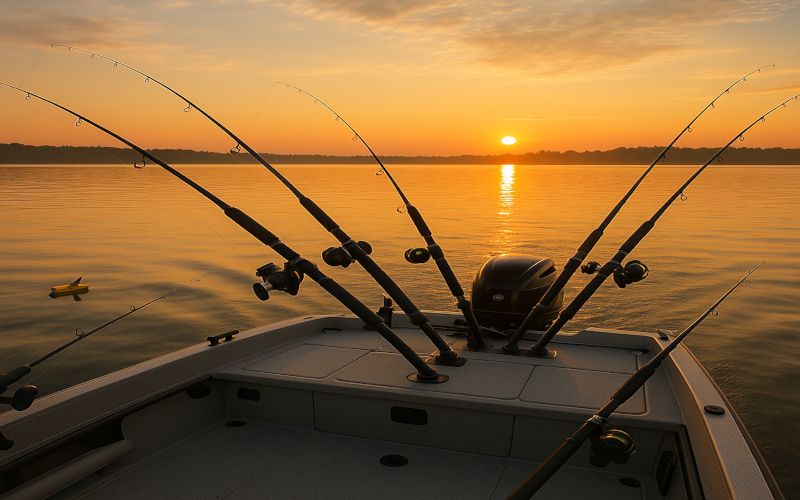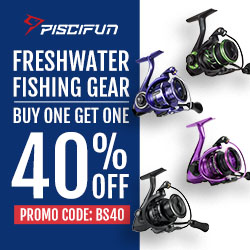Disclaimer: This post may have affiliate links. As an Amazon Associate, I earn from qualifying purchases.
Trolling Like a Pro: Cover More Water and Catch More Fish
September 23, 2025 - Reading time: 6 minutes

If casting is precision and jigging is finesse, trolling is efficiency. Trolling allows you to cover massive stretches of water with your lures constantly in motion making it one of the most effective techniques for locating and catching fish. From freshwater lakes to the open ocean, trolling is the strategy that turns long days of searching into steady action.
Why Trolling Works
Fish aren’t always clustered in one spot. They move, follow bait schools, or hold along drop-offs. Trolling keeps your bait in the strike zone while you search, letting you cover more water in less time.
Instead of fishing at fish, you’re fishing for fish setting a moving trap that eventually collides with hungry predators.
The Basics of Trolling
Step 1: Choose Your Lures
-
Crankbaits, spoons, spinners, and swimbaits are trolling staples.
-
Match lure depth to target species (shallow crank for bass, deep-diving plugs for walleye, heavy spoons for salmon).
Step 2: Set the Speed
-
Slow trolling: 1–2 mph for walleye, trout, or finicky fish.
-
Moderate: 2–3 mph for bass and pike.
-
Fast: 4+ mph for saltwater predators like tuna and king mackerel.
Step 3: Deploy Multiple Lines
Spread rods out with rod holders, planer boards, or downriggers to cover different depths and zones.
Advanced Trolling Techniques
-
Flatline Trolling
-
Lures pulled directly behind the boat. Simple and effective.
-
-
Downrigger Trolling
-
Weights (downriggers) get lures deep without heavy line drag.
-
Perfect for salmon, lake trout, or walleye suspended in deep water.
-
-
Planer Board Trolling
-
Boards pull lines away from the boat, covering a wider area.
-
Keeps lures out of prop wash and reduces spooking.
-
-
Lead Core Line Trolling
-
Special weighted line gets lures deeper without downriggers.
-
Ideal for mid-depth suspended fish.
-
Reading the Water While Trolling
-
Look for Breaks: Drop-offs, weed edges, and contour lines often hold fish.
-
Follow Bait: Birds diving? Likely a bait school below, troll through it.
-
Watch Electronics: Use sonar to track depth and mark fish.
Gear That Makes Trolling Easy
-
Rod: 7–9 foot medium power trolling rods.
-
Reels: Line-counter reels for consistent depth control.
-
Accessories: Rod holders, planer boards, and downriggers.
-
Line: Mono for shock absorption, braid for depth, fluorocarbon leaders for stealth.
👉 BEST SELLER | 20% OFF BIG DEAL – This bestseller trolling combo takes the guesswork out of setup. Perfect for multi-line spreads and handling big fish.
Common Trolling Mistakes
-
Going Too Fast: Lures look unnatural and fish won’t commit.
-
Too Much Noise: Loud engines spook fish, use quiet trolling motors when possible.
-
Ignoring Depth: Fish may be 10 feet down while your lure runs at 20. Adjust constantly.
-
Not Changing Lures: If 30 minutes pass without a hit, swap colors, sizes, or depths.
Pro Tips for Trolling Success
-
Use S-turns while trolling, inside lines slow down, outside lines speed up. This changes lure action and triggers strikes.
-
Always stagger line lengths to avoid tangles and cover more depth.
-
Pay attention to rod tips, subtle ticks or slack might mean a strike.
Trolling is the perfect blend of patience and productivity. It lets you find active fish fast and keep your baits where they matter most: in front of hungry mouths. Whether you’re chasing bass on your local lake or salmon offshore, trolling gives you a serious edge.
And the right gear makes all the difference:
👉 BEST SELLER | 20% OFF BIG DEAL
Hunting & Fishing Life - All-season outdoors living, guides, and gear reviews.
HookdLife - Outdoor stories, gear talk, and the hooked life culture.
Country Redneck - Country grit, humor, and real-life outdoor living.
Coffee & Grits - Southern mornings, hard work, and good coffee.
WolvesTale - Frontier tales and wilderness fiction inspired by the wild.
MTDLN Media Group - Explore our full outdoors and storytelling network.
